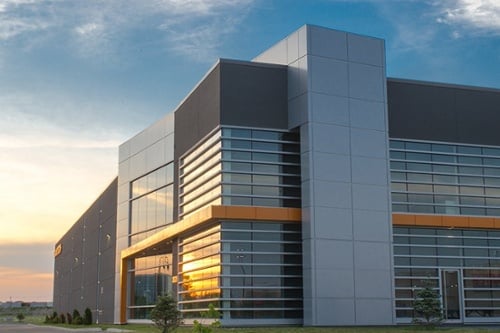A strong safety culture is the cornerstone of a successful warehouse operation. It ensures compliance and prevents accidents, but it also fosters a positive work environment that boosts employee morale and retention. As EHS Today’s 2024 survey reveals, 83% of respondents believe that a robust safety culture contributes significantly to job satisfaction.
Remember, safety isn’t a one-time event; it’s an ongoing commitment. To maintain a thriving safety culture, organizations must actively involve employees, regularly assess their programs, and adapt to evolving trends. In this blog post, we’ll explore 4 key safety tips that can help you enhance your warehouse safety initiatives.
Employees highly value a strong safety culture. Did you know nearly half of American workers (48%) would consider a pay cut for a safer work environment?

4 Key Warehouse Safety Tips
1. Supporting Mental Health
Working in a warehouse can be mentally and physically demanding, requiring sharp focus and physical strength. Poor mental health can impair a worker’s ability to identify hazards, follow proper procedures, and communicate effectively. Issues like depression can also negatively impact physical tasks and reduce cognitive performance, creating a less safe and productive environment.
As noted by Columbia Southern University, “Although mental health has been a key focus for occupational health professionals in recent years, the growing awareness of these issues and people’s willingness to speak up and seek help are expected to keep them center stage in 2024.”
Workplaces have many opportunities to promote mental health and well-being, such as:
- Offering flexible schedules
- Incorporating breaks
- Allowing time off when needed
Creating a work environment that supports mental well-being boosts productivity and can also help with employee recruitment and retention. The Deloitte Global Gen Z and Millennial survey from 2023 found that younger workers prioritize work-life balance and aren’t willing to sacrifice their mental health for work. Employers can attract and retain top talent by fostering a supportive environment while ensuring a safer and more efficient workplace.
2. Ongoing Training
While training for new employees and equipment is a standard requirement for regulatory compliance, refresher courses are just as crucial. These ongoing sessions offer numerous benefits beyond compliance, which is key to maintaining a safe and productive workplace. Here are four key reasons why refresher training should be part of your company’s training strategy:
- Staying current—According to Occupational Health & Safety, staying up to date with the latest training ensures physical labor is done correctly, using the right tools and safety equipment. Regular training helps workers stay informed about new practices and technologies, improving overall safety and efficiency.
- Preventing cumulative stress injuries—Regular ergonomics reviews can prevent musculoskeletal disorders (MSDs) caused by small, repetitive movements that are performed incorrectly. According to OSHA, work-related MSDs are a leading cause of lost or restricted work time. Refresher courses on proper body mechanics and ergonomic techniques can significantly reduce these injuries, keeping employees healthy and productive.
- Developing a safety-first mindset—Ongoing training reinforces a culture of safety. When safety is consistently prioritized through regular refreshers, it sends a clear message to employees that their well-being is at the core of the company’s values. This focus on safety can help reduce accidents and improve overall workplace morale.
- Increasing loyalty—A 2023 survey revealed that less than half (44%) of Americans feel extremely or very satisfied with the opportunities they have for training and skill development. Providing additional training, including refreshers, shows employees that the company is invested in their growth. This, in turn, boosts morale and helps with employee retention, as workers feel more valued and motivated to stay with the company.
3. Incorporating Technology into Safety Programs
Integrating technology into safety programs is a game changer, transforming operations from inefficient, paper-based processes to streamlined, automated systems. By adopting digital solutions, warehouses can boost safety, improve efficiency, and allow safety staff to focus on solving problems rather than on paperwork.
Workers also appreciate technology that enhances their efficiency. A survey by The Manufacturer found that 44% of front-line retail and warehouse workers reported increased job satisfaction when technology was introduced to support their roles. Implementing these solutions can lead to a safer, more efficient, and more satisfied workforce.
Here are some key types of technology that can significantly enhance warehouse safety and efficiency:
Warehouse Management System (WMS)
A WMS is a software solution that helps manage inventory, optimize warehouse space, and track goods. When integrated with safety programs, WMS can monitor inventory placement to prevent rack overloading, track product movements to identify hazards and congestion, and enhance communication for efficient adherence to safety procedures during operations.
Examples of WMS software include SAP EWM, Oracle WMS, and Manhattan Active. These systems manage inventory and can contribute to safer workflows by helping operators avoid overloading racks and ensuring goods are stored properly.
Environmental, Health, and Safety (EHS) Compliance Software
Environmental, Health, and Safety (EHS) compliance software is designed to help warehouses maintain compliance with industry safety standards and regulations. It automates tracking, reporting, and auditing processes related to workplace safety, helping identify risks and ensuring that necessary actions are taken. Benefits include tracking potential hazards, managing corrective actions, and providing analytics to improve safety measures. The software also streamlines the process of documenting accidents and near misses to analyze patterns and prevent future incidents.
Examples of EHS software include Intelex, Enablon, and VelocityEHS. These platforms make it easier to maintain compliance with standards like OSHA, track safety performance, and ensure continuous improvement in safety protocols.
Computerized Maintenance Management System (CMMS)
A CMMS helps manage maintenance activities, ensuring that warehouse equipment is always in optimal condition. This software automates maintenance requests and ensures inspections or servicing occur at the correct intervals to reduce equipment failure, while also prioritizing repair or maintenance requests based on severity, allowing safety teams to address critical issues quickly.
Examples of CMMS solutions include Fiix, UpKeep, and IBM Maximo. By automating maintenance management, these tools help warehouses minimize downtime and prevent accidents due to poorly maintained equipment.
Automated Safety Inspection Tools
Automated inspection tools, such as mobile inspection apps or cloud-based platforms, can be used to perform regular inspections and audits of pallet racks and equipment. For example, the Damotech Platform is a cloud-based tool that allows users to conduct rack inspections digitally, keep detailed records of rack conditions with photos and notes, and generate reports and track the status of repairs.
These tools make it easier to manage and track inspection results, ensuring that safety hazards are addressed promptly.
By integrating these technologies, warehouses can create a safer, more productive environment while ensuring compliance with safety regulations. Moving to digital solutions is not just about efficiency, it’s about investing in the health, safety, and satisfaction of your workforce.
4. Prioritizing Frequent Rack Inspections
Pallet racks endure significant wear and tear from daily use, forklifts, and heavy loads, which can weaken their structural integrity over time. Ask yourself: Are you putting off rack repairs too long? If so, what are the consequences?
Damaged or overloaded racks pose serious risks to workers and inventory, making it essential to identify and address these issues before they lead to failures. Delaying rack inspections or repairs can lead to costly accidents, downtime, and compliance issues. In today’s demanding material handling industry, staying ahead of potential problems is essential—partner with a trusted rack repair expert who can help you maintain regular inspections and repairs.
Schedule inspections early and often—don’t wait until it’s too late. Rack inspections are a cornerstone of any comprehensive warehouse safety program and a proactive step to prevent costly accidents and downtime. The benefits of frequent rack inspections include the following:
- Early detection of issues prevents costly accidents, injuries, and downtime.
- Regular inspections help ensure compliance with OSHA and other safety standards.
- Addressing minor damage early reduces the risk of catastrophic rack collapses and expensive repairs.
- Workers feel safer knowing their equipment is regularly inspected and maintained.
Best Practices for Rack Inspections:
- Conduct inspections at least quarterly or after any incidents that could impact rack stability.
- Train employees to recognize visible signs of damage, such as bent posts, missing safety clips, or overloaded beams.
- Use specialized tools or software, like the Damotech Platform, to digitally track rack conditions, schedule repairs, and maintain a historical record of inspections.
- Frequent rack inspections reduce risks and align with a safety culture that values proactive measures instead of reactive responses.
Combined with the other three trends, regular inspections strengthen the foundation of a safer, more productive warehouse environment. Make inspections a priority and reinforce your commitment to safety today!
Conclusion: Strengthen Your Warehouse Safety Program with These 4 Warehouse Safety Tips
Building a strong safety culture is not only about compliance but also about creating a workplace where employees feel valued and secure. The four safety trends we’ve discussed—supporting mental health, ongoing training, and incorporating technology—are critical steps toward achieving a safer, more productive warehouse environment. Implementing these practices can boost employee morale, increase retention, and reduce accidents.
However, a truly robust safety program goes beyond trends. It requires a commitment to continuous improvement and proactive measures to protect your workforce. If you’re ready to take your warehouse safety program to the next level, we’ve made it easy for you to get started.

Download our free bundle today for expert guidance on creating and maintaining a comprehensive rack safety program. This valuable resource will help you identify risks, ensure compliance, and plan—keeping your warehouse safe and efficient.
Don’t wait—start reinforcing your safety program now and set your team up for success!








